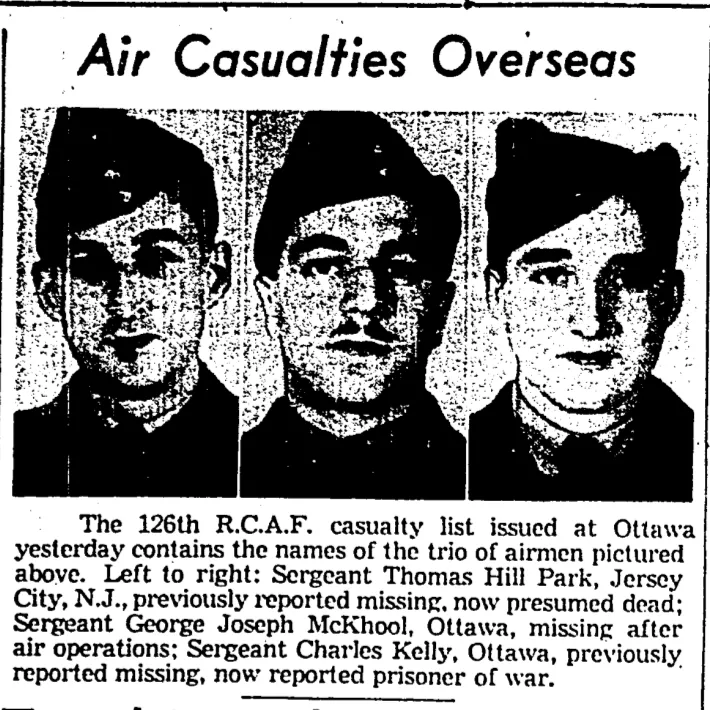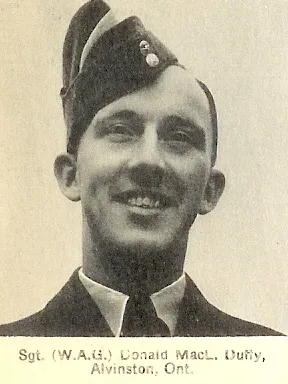Park, Thomas Hill (Sergeant)
Killed in Action 1941-August-19


Birth Date: 1909-June-25
Born:
Parents: Son of James and Charlotte Park, of Jersey City, U.S.A.
Spouse:
Home: Jersey City, New Jersey, USA
Enlistment:
Enlistment Date: unkown date
Service
RCAF
Unit
10 Sqn- Squadron (RAF)
Rem Acu Tangere To hit the mark
Base
Rank
Sergeant
Position
Air Gunner
Service Numbers
R/72165
Whitley serial: Z6564

The Armstrong Whitworth AW 38 Whitley was one of three British twin-engined, front line bomber types that were in service with the Royal Air Force (RAF) at the outbreak of the Second World War. Alongside the Vickers Wellington and the Handley Page Hampden, the Whitley was developed during the mid-1930s according to Air Ministry Specification B.3/34, which it was subsequently selected to meet. In 1937, the Whitley formally entered into RAF squadron service; it was the first of the three medium bombers to be introduced. Following the outbreak of war in September 1939, the Whitley participated in the first RAF bombing raid upon German territory and remained an integral part of the early British bomber offensive. In 1942 it was superseded as a bomber by the larger four-engined "heavies" such as the Avro Lancaster. Its front line service included maritime reconnaissance with Coastal Command and the second line roles of glider-tug, trainer and transport aircraft. The type was also procured by British Overseas Airways Corporation as a civilian freighter aircraft. The aircraft was named after Whitley, a suburb of Coventry, home of one of Armstrong Whitworth's plants.
John Lloyd, the Chief Designer of Armstrong Whitworth Aircraft, selected the Armstrong Siddeley Tiger IX radial engine to power the Whitley, which was capable of generating 795 hp (593 kW). One of the more innovative features of the Whitley's design was the adoption of a three-bladed two-position variable-pitch propeller built by de Havilland; the Whitley was the first aircraft to fly with such an arrangement. Lloyd was unfamiliar with the use of flaps on a large heavy monoplane, they were initially omitted from the design. To compensate, the mid-set wings were set at a high angle of incidence (8.5°) to confer good take-off and landing performance. Although flaps were included late in the design stage, the wing remained unaltered; as a result, the Whitley flew with a pronounced nose-down attitude when at cruising speed, resulting in considerable drag. The Whitley holds the distinction of having been the first RAF aircraft with a semi-monocoque fuselage, which was built using a slab-sided structure to ease production. This replaced the tubular construction method traditionally employed by Armstrong Whitworth, who instead constructed the airframe from light-alloy rolled sections, pressings and corrugated sheets.
The Whitley had a crew of five: a pilot, co-pilot/navigator, a bomb aimer, a wireless operator and a rear gunner. The pilot and second pilot/navigator sat side by side in the cockpit, with the wireless operator further back. The navigator, his seat mounted on rails and able to pivot, slid backwards and rotated to the left to use the chart table behind him after takeoff. The bomb aimer position was in the nose with a gun turret located directly above. The fuselage aft of the wireless operator was divided horizontally by the bomb bay; behind the bomb bay was the main entrance and aft of that the rear turret. The offensive armaments were stowed in two bomb bays housed within the fuselage, along with a further 14 smaller cells in the wing. Other sources state there were 16 "cells" total: two groups of 2 in the fuselage, and four groups of 3 in the wings, plus two smaller cells for parachute flares in the rear fuselage. Bomb racks capable of holding larger bombs were installed on the Whitley Mk III variant. Wikipedia
![]() Wikipedia Armstrong Whitworth Whitley
Wikipedia Armstrong Whitworth Whitley
Unit Desciption
10 Sqn Rem Acu Tangere (Blackburn's Own)
No 10 Squadron RFC was originally formed at Farnborough, Hampshire on January 1, 1915. It served on the Western Front in WWI, transferring to the RAF when the latter was formed in 1918. The squadron returned to England in February 1919 and was disbanded on December 31.
The squadron was re-formed as a heavy bomber unit in January 1928. A heavy-bomber unit, it flew Handley-Page Hyderabads, followed by Hinaidis and then Heyfords through the 1930s. By the time that WWII started, the squadron was equipped with Armstrong-Whitworth Whitley aircraft. Operating from Dishforth, Yorkshire, it took part in a number of leaflet raids over Germany, including being the first RAF aircraft to drop leaflets over Berlin on 1/2 October 1939. Detachments of the Squadron were based in France (Villeneuve) and Scotland (Kinloss), between October 1939 and March 1940, the latter being with Coastal Command. The squadron's first bombing raid was on the night of 19/20 March, 1940, attacking the German mining seaplane base at Hornum, on the island of Sylt. When Italy entered the war in June 1940, the squadron flew from Guernsey in the Channel Islands to attack targets in Italy.
In July 1940 the squadron moved to the nearby base of Leeming, Yorkshire, where it remained until August 1942. From December 1942 the squadron was re-equipped with Halifax aircraft. In the first quarter of 1942, There were detachments to Lossiemouth, Scotland, for operations against the battleship Tirpitz, which at that time was based near Trondheim, Norway. It was on one of these operations, on the night of 27/28 April that the squadron commander. W/C D.C.T. Bennett, was shot down, but he and his crew escaped to Sweden and were interned and subsequently returned to England. W/C (later Air Vice Marshal) Bennet subsequently was appointed to form and lead the Pathfinder Force, which became No. 8 Group of Bomber Command. From June 1942 a detachment of the squadron (16 aircraft and crews) moved to Palestine and then to Egypt, operating against Tobruk. This detachment then combined with No. 6/462 squadron to form No.462 (RAAF) Squadron in September 1942. The main No. 10 Squadron continued to operate with No. 4 Group, Bomber Command from Leeming at this time, but then moved to Melbourne, Yorkshire in August 1942, where it remained until May 1945. It was transferred to Transport Command on May 7, 1945 and disbanded on December 20 1947. It later was re-formed and flew Canberras and Victors.

